Hospitality Operations Report
VerifiedAdded on 2020/12/09
|17
|4225
|457
Report
AI Summary
This report examines the hospitality operations of Celeste Restaurant in Lanesborough Hotel, London, focusing on menu engineering and incorporating healthier options. It explores the history of menus, analyzes the Food and Beverage Director's role, and discusses strategies for promoting healthy eating habits while considering nutritional concerns.
Contribute Materials
Your contribution can guide someone’s learning journey. Share your
documents today.
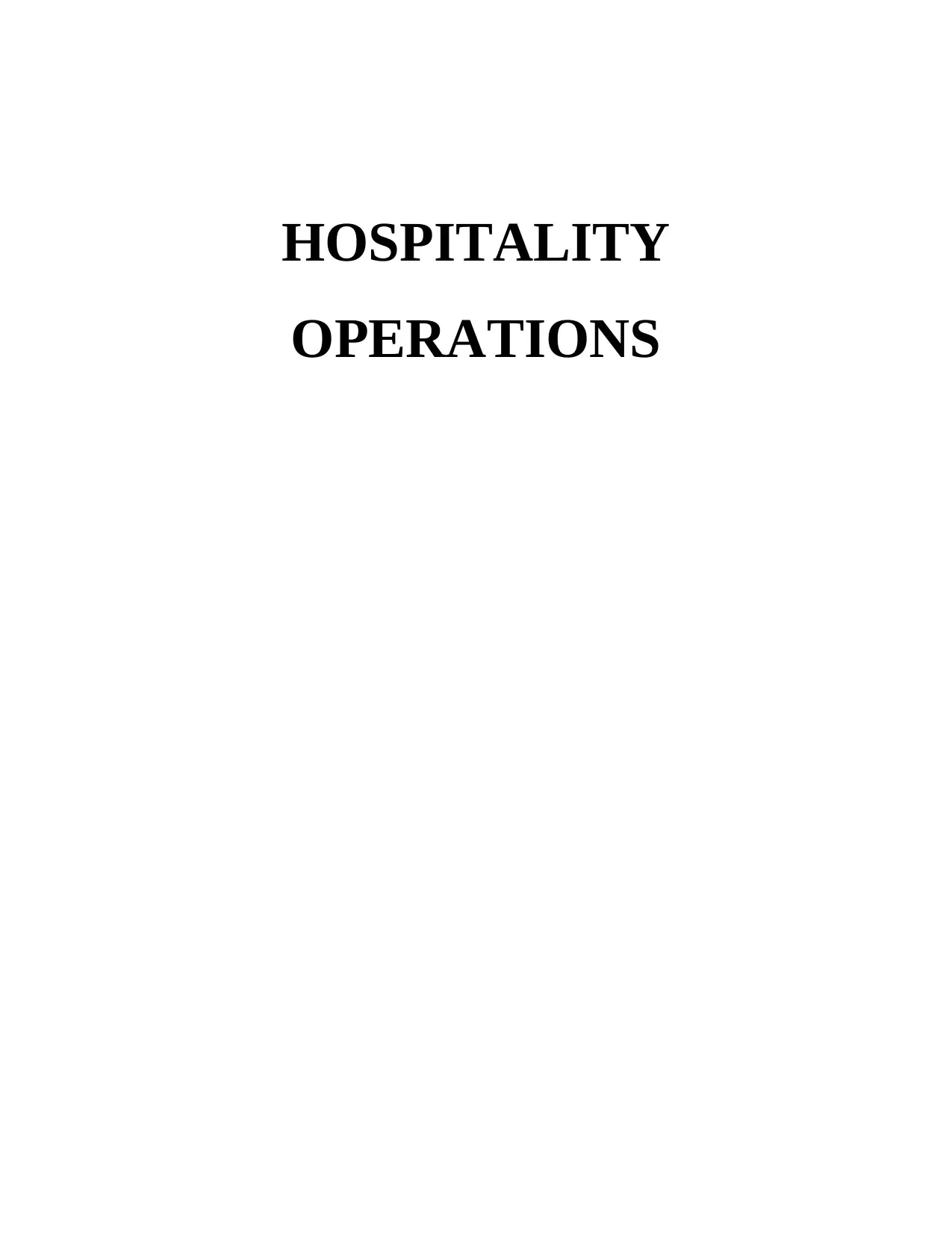
HOSPITALITY
OPERATIONS
OPERATIONS
Secure Best Marks with AI Grader
Need help grading? Try our AI Grader for instant feedback on your assignments.
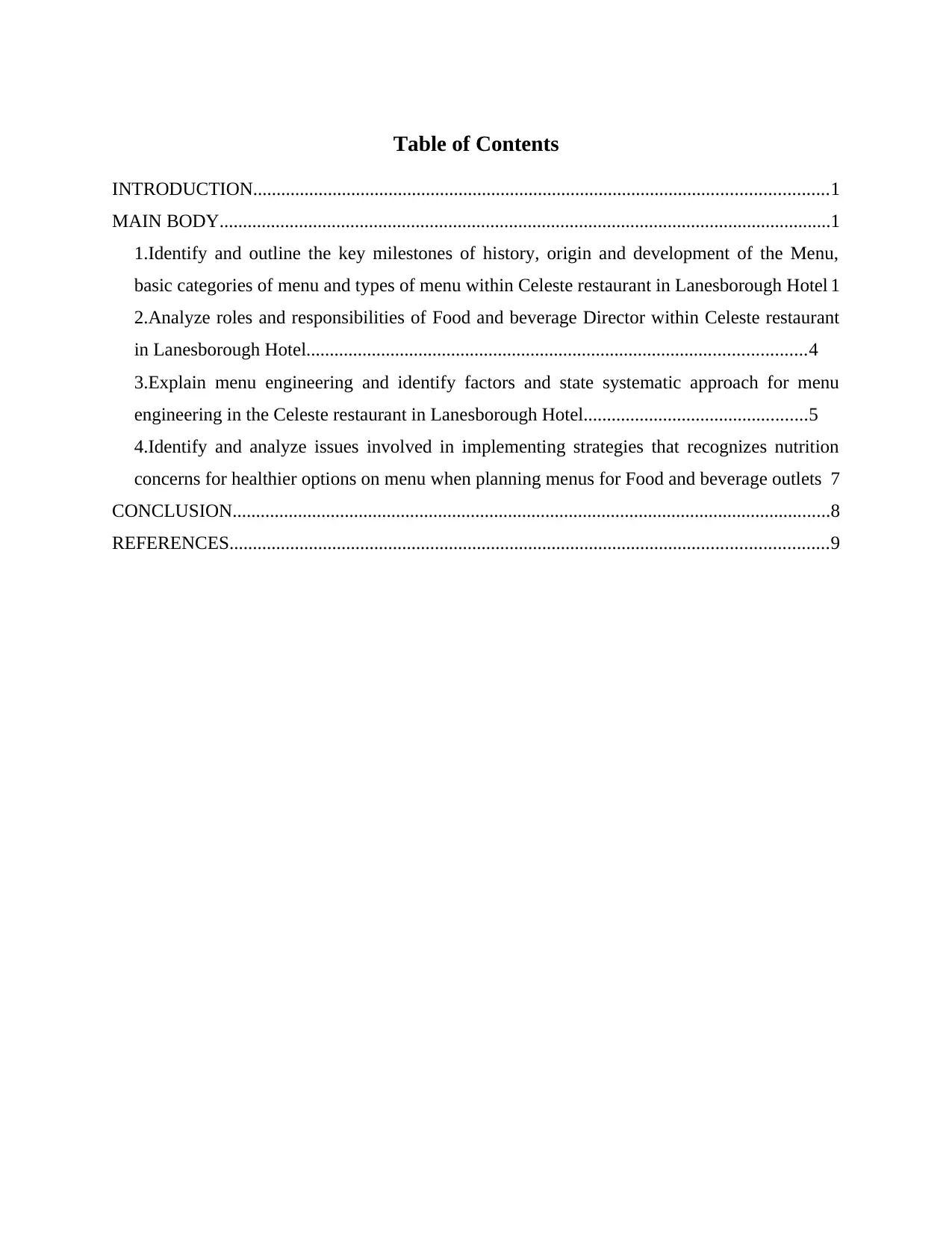
Table of Contents
INTRODUCTION...........................................................................................................................1
MAIN BODY...................................................................................................................................1
1.Identify and outline the key milestones of history, origin and development of the Menu,
basic categories of menu and types of menu within Celeste restaurant in Lanesborough Hotel 1
2.Analyze roles and responsibilities of Food and beverage Director within Celeste restaurant
in Lanesborough Hotel...........................................................................................................4
3.Explain menu engineering and identify factors and state systematic approach for menu
engineering in the Celeste restaurant in Lanesborough Hotel................................................5
4.Identify and analyze issues involved in implementing strategies that recognizes nutrition
concerns for healthier options on menu when planning menus for Food and beverage outlets 7
CONCLUSION................................................................................................................................8
REFERENCES................................................................................................................................9
INTRODUCTION...........................................................................................................................1
MAIN BODY...................................................................................................................................1
1.Identify and outline the key milestones of history, origin and development of the Menu,
basic categories of menu and types of menu within Celeste restaurant in Lanesborough Hotel 1
2.Analyze roles and responsibilities of Food and beverage Director within Celeste restaurant
in Lanesborough Hotel...........................................................................................................4
3.Explain menu engineering and identify factors and state systematic approach for menu
engineering in the Celeste restaurant in Lanesborough Hotel................................................5
4.Identify and analyze issues involved in implementing strategies that recognizes nutrition
concerns for healthier options on menu when planning menus for Food and beverage outlets 7
CONCLUSION................................................................................................................................8
REFERENCES................................................................................................................................9
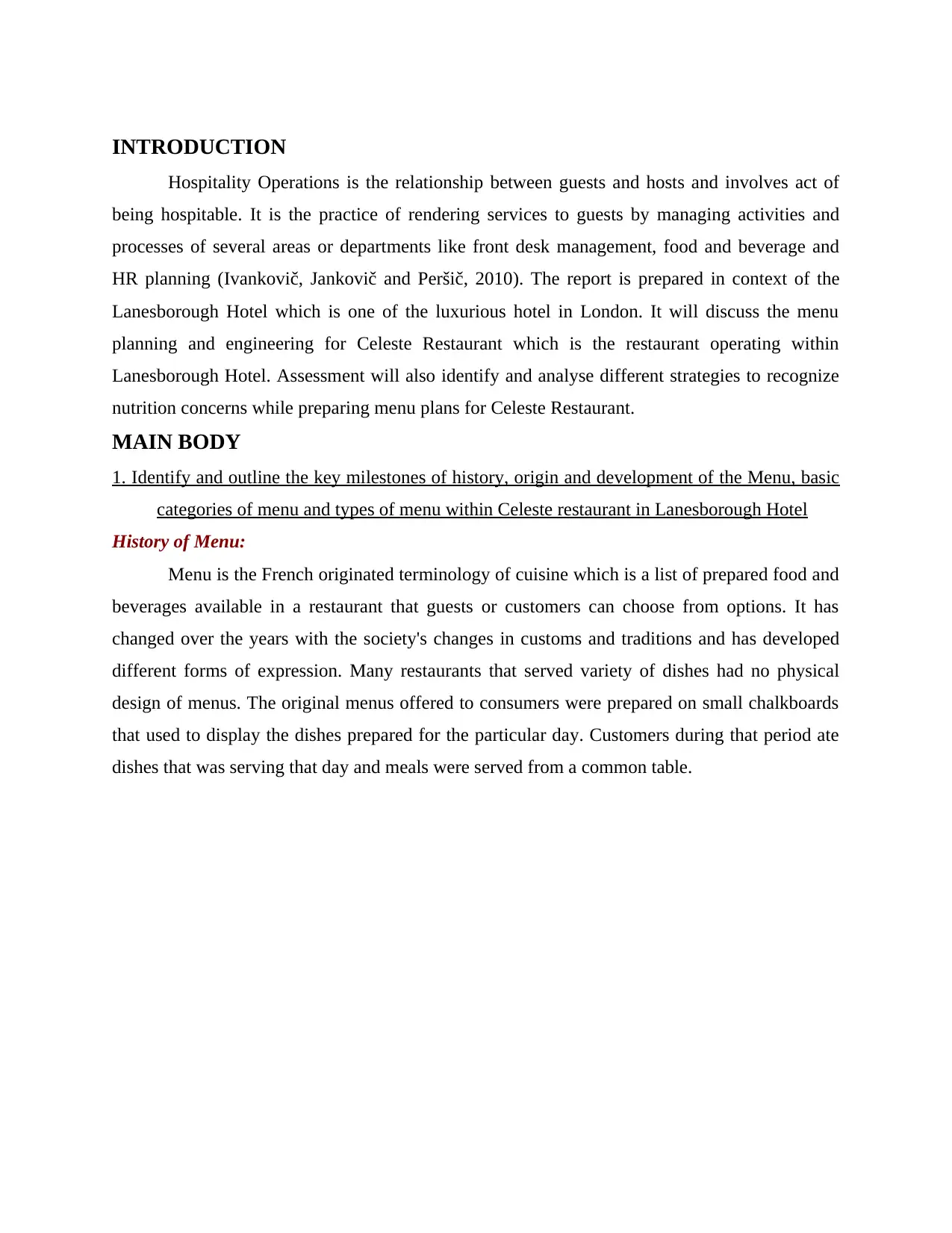
INTRODUCTION
Hospitality Operations is the relationship between guests and hosts and involves act of
being hospitable. It is the practice of rendering services to guests by managing activities and
processes of several areas or departments like front desk management, food and beverage and
HR planning (Ivankovič, Jankovič and Peršič, 2010). The report is prepared in context of the
Lanesborough Hotel which is one of the luxurious hotel in London. It will discuss the menu
planning and engineering for Celeste Restaurant which is the restaurant operating within
Lanesborough Hotel. Assessment will also identify and analyse different strategies to recognize
nutrition concerns while preparing menu plans for Celeste Restaurant.
MAIN BODY
1. Identify and outline the key milestones of history, origin and development of the Menu, basic
categories of menu and types of menu within Celeste restaurant in Lanesborough Hotel
History of Menu:
Menu is the French originated terminology of cuisine which is a list of prepared food and
beverages available in a restaurant that guests or customers can choose from options. It has
changed over the years with the society's changes in customs and traditions and has developed
different forms of expression. Many restaurants that served variety of dishes had no physical
design of menus. The original menus offered to consumers were prepared on small chalkboards
that used to display the dishes prepared for the particular day. Customers during that period ate
dishes that was serving that day and meals were served from a common table.
Hospitality Operations is the relationship between guests and hosts and involves act of
being hospitable. It is the practice of rendering services to guests by managing activities and
processes of several areas or departments like front desk management, food and beverage and
HR planning (Ivankovič, Jankovič and Peršič, 2010). The report is prepared in context of the
Lanesborough Hotel which is one of the luxurious hotel in London. It will discuss the menu
planning and engineering for Celeste Restaurant which is the restaurant operating within
Lanesborough Hotel. Assessment will also identify and analyse different strategies to recognize
nutrition concerns while preparing menu plans for Celeste Restaurant.
MAIN BODY
1. Identify and outline the key milestones of history, origin and development of the Menu, basic
categories of menu and types of menu within Celeste restaurant in Lanesborough Hotel
History of Menu:
Menu is the French originated terminology of cuisine which is a list of prepared food and
beverages available in a restaurant that guests or customers can choose from options. It has
changed over the years with the society's changes in customs and traditions and has developed
different forms of expression. Many restaurants that served variety of dishes had no physical
design of menus. The original menus offered to consumers were prepared on small chalkboards
that used to display the dishes prepared for the particular day. Customers during that period ate
dishes that was serving that day and meals were served from a common table.
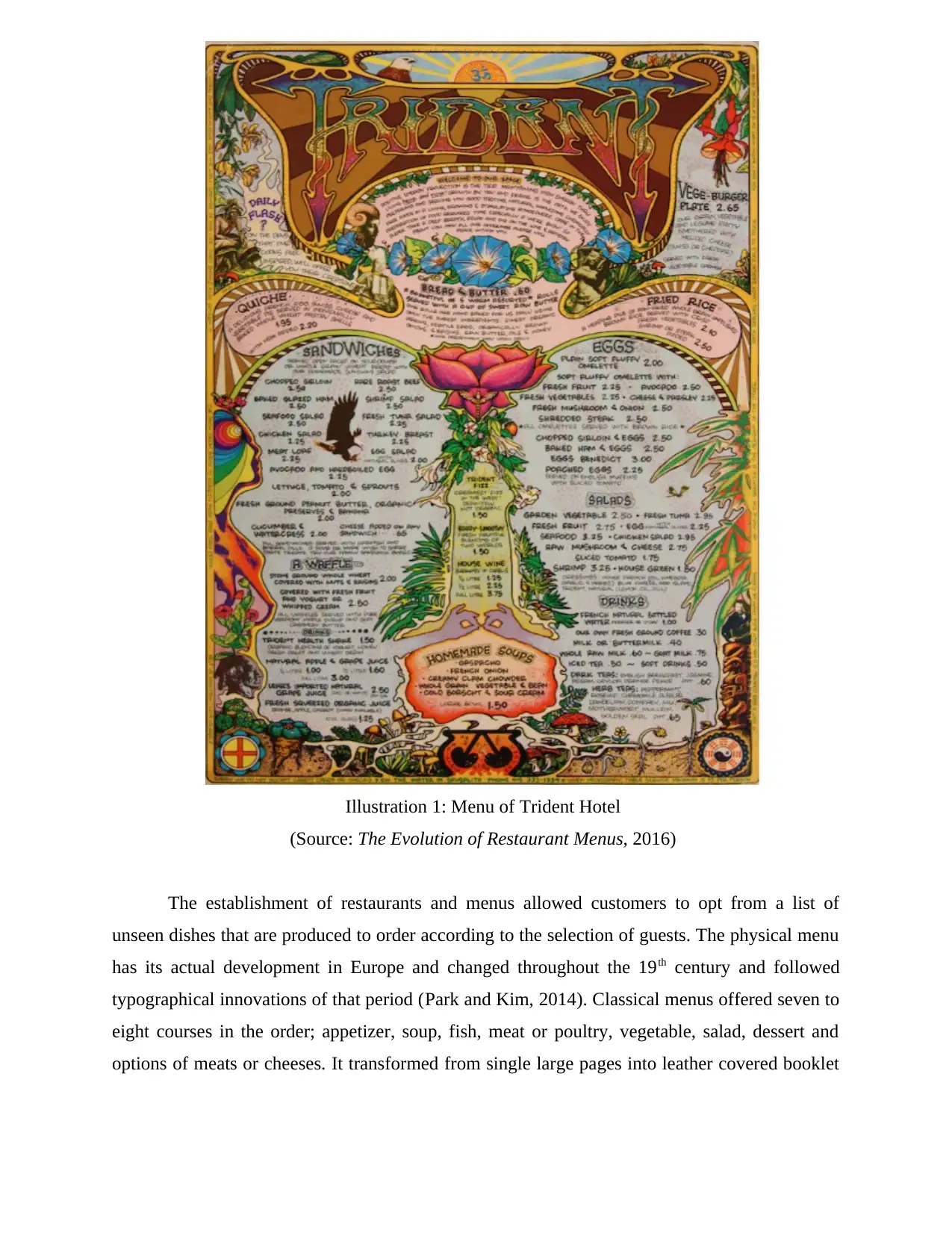
The establishment of restaurants and menus allowed customers to opt from a list of
unseen dishes that are produced to order according to the selection of guests. The physical menu
has its actual development in Europe and changed throughout the 19th century and followed
typographical innovations of that period (Park and Kim, 2014). Classical menus offered seven to
eight courses in the order; appetizer, soup, fish, meat or poultry, vegetable, salad, dessert and
options of meats or cheeses. It transformed from single large pages into leather covered booklet
Illustration 1: Menu of Trident Hotel
(Source: The Evolution of Restaurant Menus, 2016)
unseen dishes that are produced to order according to the selection of guests. The physical menu
has its actual development in Europe and changed throughout the 19th century and followed
typographical innovations of that period (Park and Kim, 2014). Classical menus offered seven to
eight courses in the order; appetizer, soup, fish, meat or poultry, vegetable, salad, dessert and
options of meats or cheeses. It transformed from single large pages into leather covered booklet
Illustration 1: Menu of Trident Hotel
(Source: The Evolution of Restaurant Menus, 2016)
Secure Best Marks with AI Grader
Need help grading? Try our AI Grader for instant feedback on your assignments.
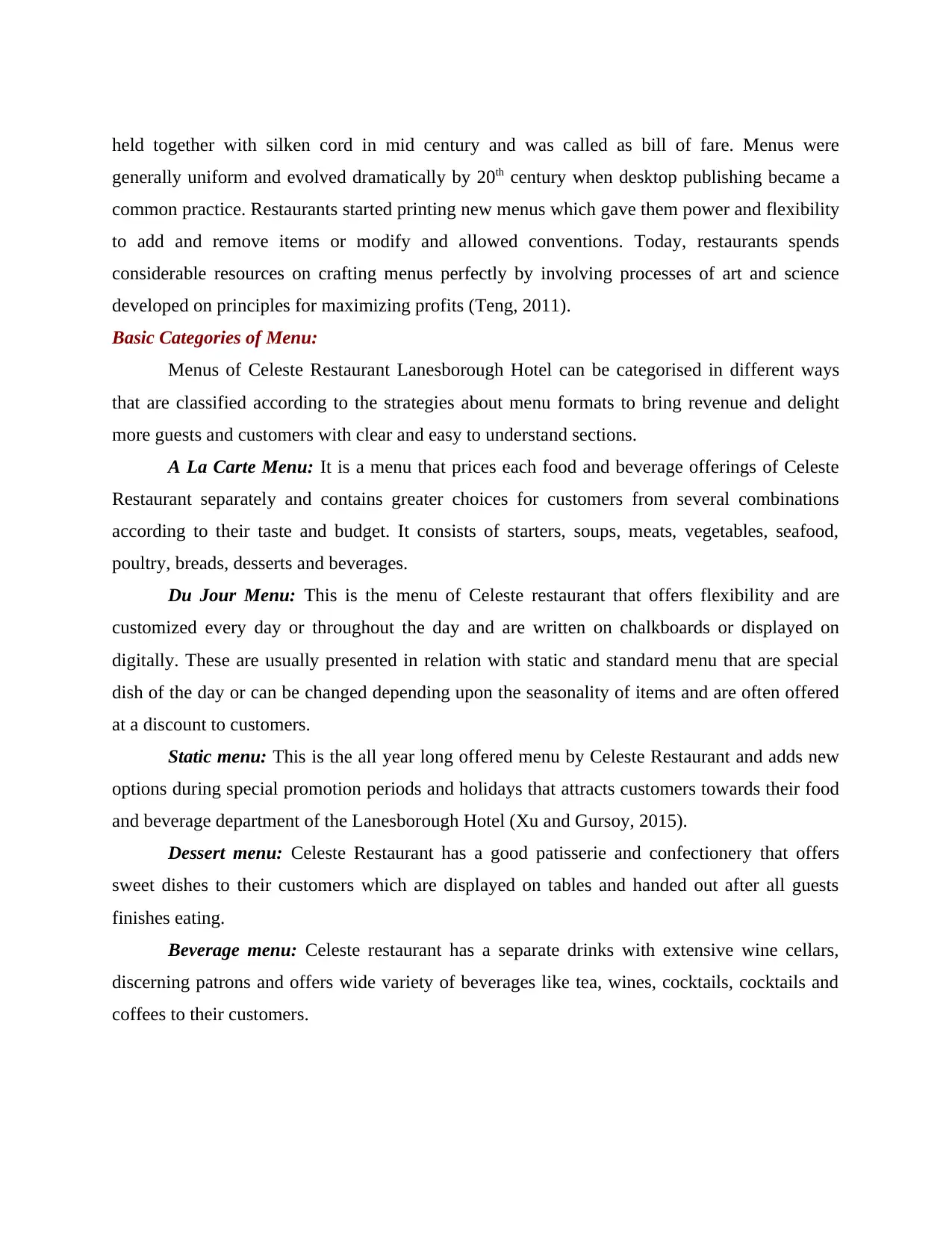
held together with silken cord in mid century and was called as bill of fare. Menus were
generally uniform and evolved dramatically by 20th century when desktop publishing became a
common practice. Restaurants started printing new menus which gave them power and flexibility
to add and remove items or modify and allowed conventions. Today, restaurants spends
considerable resources on crafting menus perfectly by involving processes of art and science
developed on principles for maximizing profits (Teng, 2011).
Basic Categories of Menu:
Menus of Celeste Restaurant Lanesborough Hotel can be categorised in different ways
that are classified according to the strategies about menu formats to bring revenue and delight
more guests and customers with clear and easy to understand sections.
A La Carte Menu: It is a menu that prices each food and beverage offerings of Celeste
Restaurant separately and contains greater choices for customers from several combinations
according to their taste and budget. It consists of starters, soups, meats, vegetables, seafood,
poultry, breads, desserts and beverages.
Du Jour Menu: This is the menu of Celeste restaurant that offers flexibility and are
customized every day or throughout the day and are written on chalkboards or displayed on
digitally. These are usually presented in relation with static and standard menu that are special
dish of the day or can be changed depending upon the seasonality of items and are often offered
at a discount to customers.
Static menu: This is the all year long offered menu by Celeste Restaurant and adds new
options during special promotion periods and holidays that attracts customers towards their food
and beverage department of the Lanesborough Hotel (Xu and Gursoy, 2015).
Dessert menu: Celeste Restaurant has a good patisserie and confectionery that offers
sweet dishes to their customers which are displayed on tables and handed out after all guests
finishes eating.
Beverage menu: Celeste restaurant has a separate drinks with extensive wine cellars,
discerning patrons and offers wide variety of beverages like tea, wines, cocktails, cocktails and
coffees to their customers.
generally uniform and evolved dramatically by 20th century when desktop publishing became a
common practice. Restaurants started printing new menus which gave them power and flexibility
to add and remove items or modify and allowed conventions. Today, restaurants spends
considerable resources on crafting menus perfectly by involving processes of art and science
developed on principles for maximizing profits (Teng, 2011).
Basic Categories of Menu:
Menus of Celeste Restaurant Lanesborough Hotel can be categorised in different ways
that are classified according to the strategies about menu formats to bring revenue and delight
more guests and customers with clear and easy to understand sections.
A La Carte Menu: It is a menu that prices each food and beverage offerings of Celeste
Restaurant separately and contains greater choices for customers from several combinations
according to their taste and budget. It consists of starters, soups, meats, vegetables, seafood,
poultry, breads, desserts and beverages.
Du Jour Menu: This is the menu of Celeste restaurant that offers flexibility and are
customized every day or throughout the day and are written on chalkboards or displayed on
digitally. These are usually presented in relation with static and standard menu that are special
dish of the day or can be changed depending upon the seasonality of items and are often offered
at a discount to customers.
Static menu: This is the all year long offered menu by Celeste Restaurant and adds new
options during special promotion periods and holidays that attracts customers towards their food
and beverage department of the Lanesborough Hotel (Xu and Gursoy, 2015).
Dessert menu: Celeste Restaurant has a good patisserie and confectionery that offers
sweet dishes to their customers which are displayed on tables and handed out after all guests
finishes eating.
Beverage menu: Celeste restaurant has a separate drinks with extensive wine cellars,
discerning patrons and offers wide variety of beverages like tea, wines, cocktails, cocktails and
coffees to their customers.
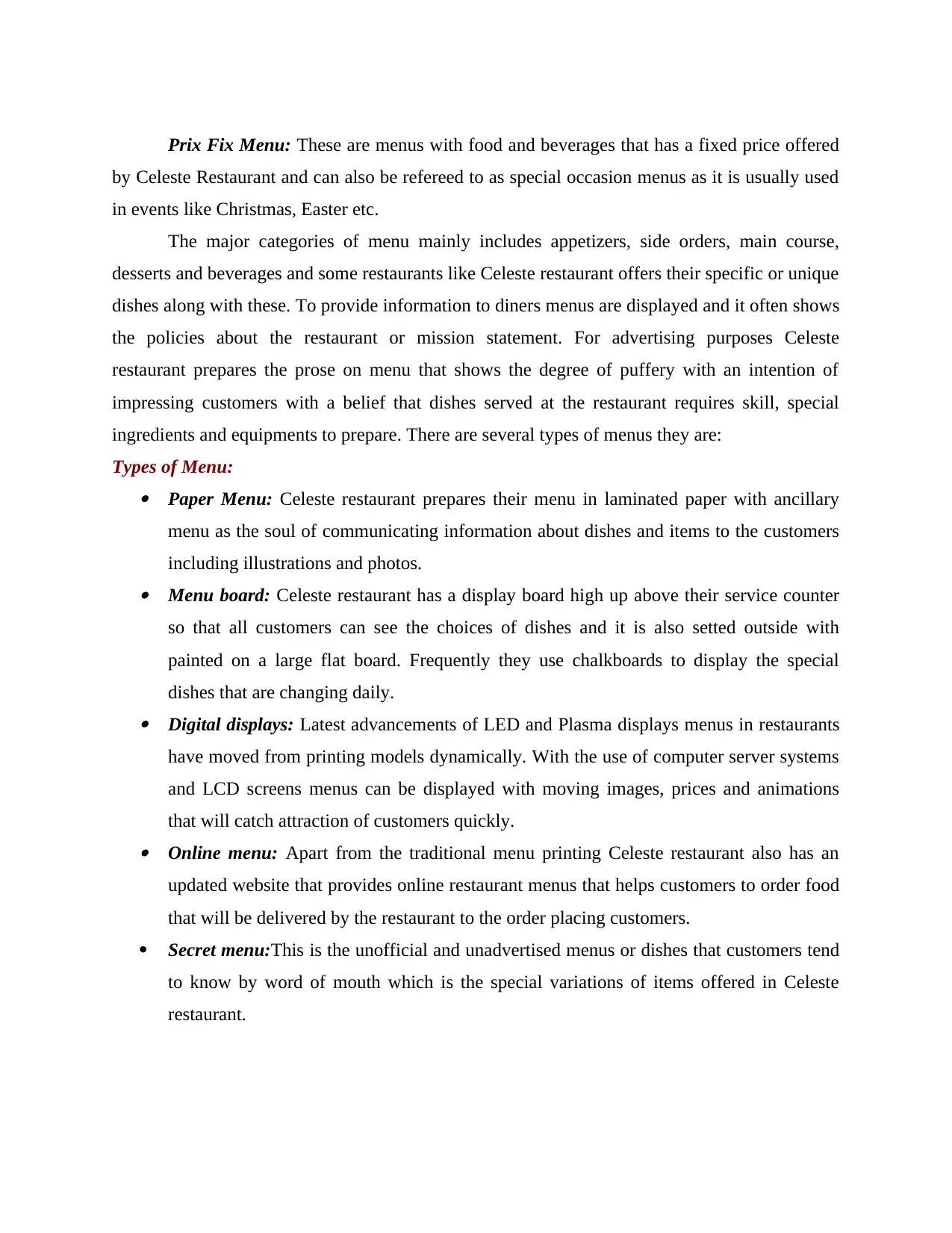
Prix Fix Menu: These are menus with food and beverages that has a fixed price offered
by Celeste Restaurant and can also be refereed to as special occasion menus as it is usually used
in events like Christmas, Easter etc.
The major categories of menu mainly includes appetizers, side orders, main course,
desserts and beverages and some restaurants like Celeste restaurant offers their specific or unique
dishes along with these. To provide information to diners menus are displayed and it often shows
the policies about the restaurant or mission statement. For advertising purposes Celeste
restaurant prepares the prose on menu that shows the degree of puffery with an intention of
impressing customers with a belief that dishes served at the restaurant requires skill, special
ingredients and equipments to prepare. There are several types of menus they are:
Types of Menu: Paper Menu: Celeste restaurant prepares their menu in laminated paper with ancillary
menu as the soul of communicating information about dishes and items to the customers
including illustrations and photos. Menu board: Celeste restaurant has a display board high up above their service counter
so that all customers can see the choices of dishes and it is also setted outside with
painted on a large flat board. Frequently they use chalkboards to display the special
dishes that are changing daily. Digital displays: Latest advancements of LED and Plasma displays menus in restaurants
have moved from printing models dynamically. With the use of computer server systems
and LCD screens menus can be displayed with moving images, prices and animations
that will catch attraction of customers quickly. Online menu: Apart from the traditional menu printing Celeste restaurant also has an
updated website that provides online restaurant menus that helps customers to order food
that will be delivered by the restaurant to the order placing customers.
Secret menu:This is the unofficial and unadvertised menus or dishes that customers tend
to know by word of mouth which is the special variations of items offered in Celeste
restaurant.
by Celeste Restaurant and can also be refereed to as special occasion menus as it is usually used
in events like Christmas, Easter etc.
The major categories of menu mainly includes appetizers, side orders, main course,
desserts and beverages and some restaurants like Celeste restaurant offers their specific or unique
dishes along with these. To provide information to diners menus are displayed and it often shows
the policies about the restaurant or mission statement. For advertising purposes Celeste
restaurant prepares the prose on menu that shows the degree of puffery with an intention of
impressing customers with a belief that dishes served at the restaurant requires skill, special
ingredients and equipments to prepare. There are several types of menus they are:
Types of Menu: Paper Menu: Celeste restaurant prepares their menu in laminated paper with ancillary
menu as the soul of communicating information about dishes and items to the customers
including illustrations and photos. Menu board: Celeste restaurant has a display board high up above their service counter
so that all customers can see the choices of dishes and it is also setted outside with
painted on a large flat board. Frequently they use chalkboards to display the special
dishes that are changing daily. Digital displays: Latest advancements of LED and Plasma displays menus in restaurants
have moved from printing models dynamically. With the use of computer server systems
and LCD screens menus can be displayed with moving images, prices and animations
that will catch attraction of customers quickly. Online menu: Apart from the traditional menu printing Celeste restaurant also has an
updated website that provides online restaurant menus that helps customers to order food
that will be delivered by the restaurant to the order placing customers.
Secret menu:This is the unofficial and unadvertised menus or dishes that customers tend
to know by word of mouth which is the special variations of items offered in Celeste
restaurant.
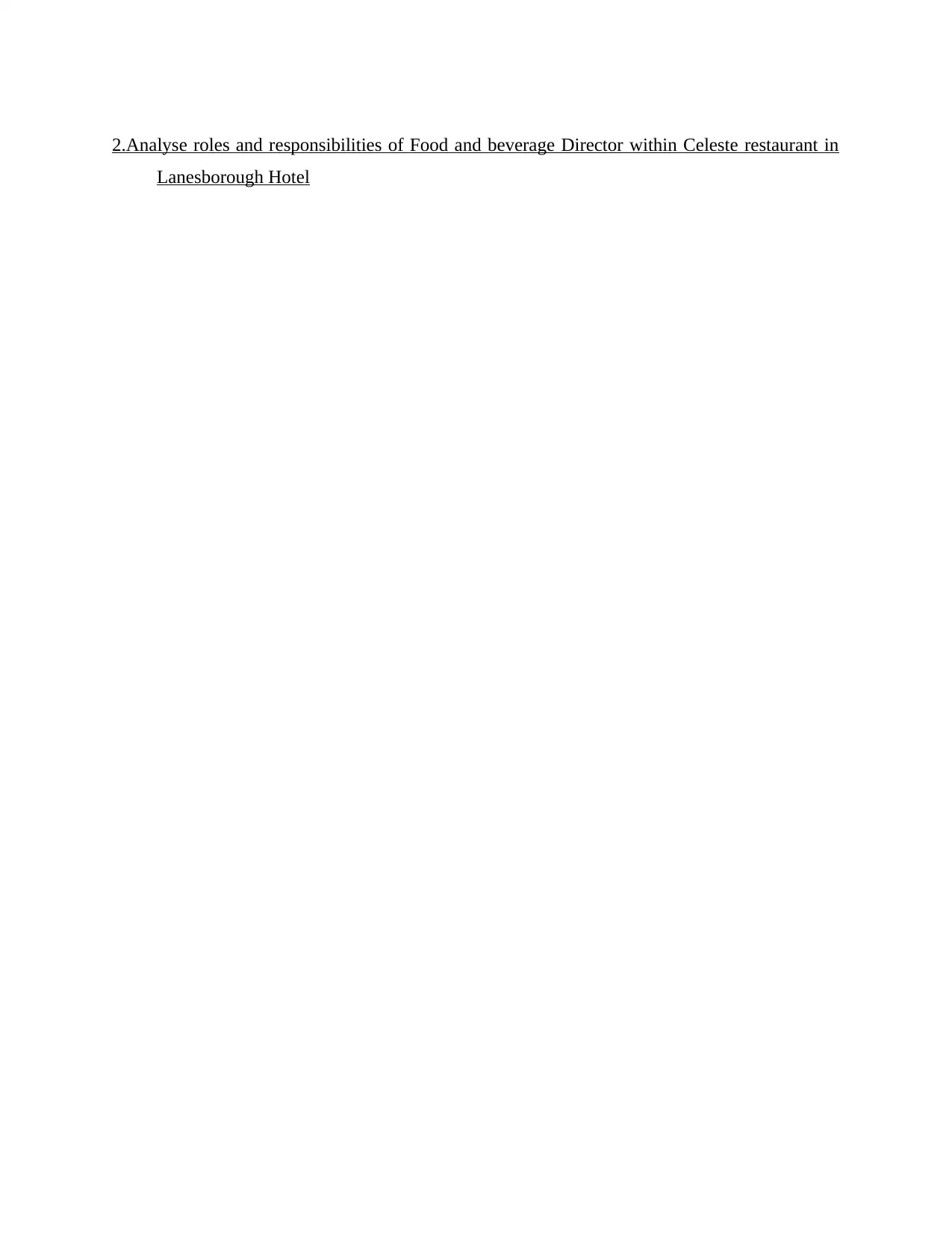
2.Analyse roles and responsibilities of Food and beverage Director within Celeste restaurant in
Lanesborough Hotel
Lanesborough Hotel
Paraphrase This Document
Need a fresh take? Get an instant paraphrase of this document with our AI Paraphraser
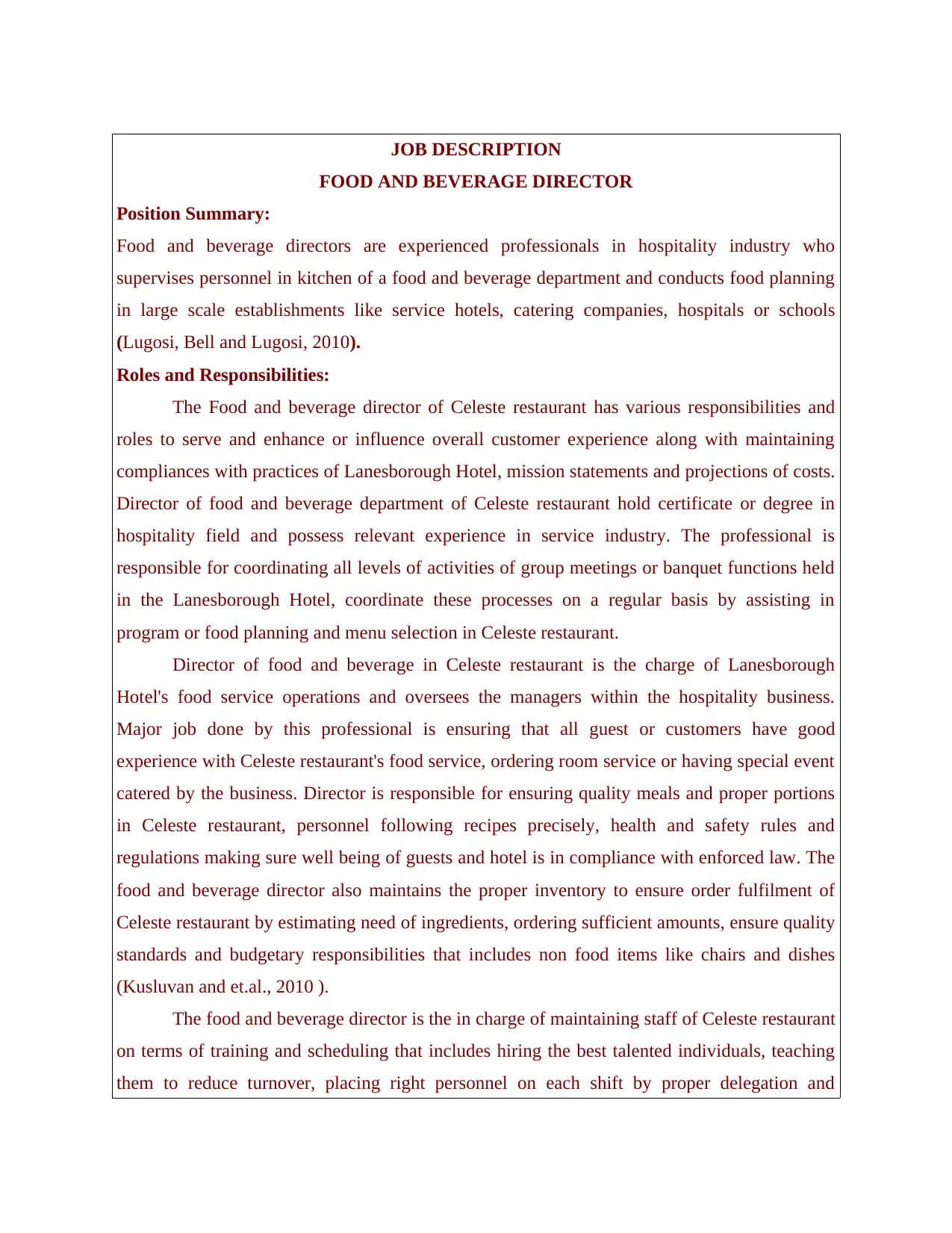
JOB DESCRIPTION
FOOD AND BEVERAGE DIRECTOR
Position Summary:
Food and beverage directors are experienced professionals in hospitality industry who
supervises personnel in kitchen of a food and beverage department and conducts food planning
in large scale establishments like service hotels, catering companies, hospitals or schools
(Lugosi, Bell and Lugosi, 2010).
Roles and Responsibilities:
The Food and beverage director of Celeste restaurant has various responsibilities and
roles to serve and enhance or influence overall customer experience along with maintaining
compliances with practices of Lanesborough Hotel, mission statements and projections of costs.
Director of food and beverage department of Celeste restaurant hold certificate or degree in
hospitality field and possess relevant experience in service industry. The professional is
responsible for coordinating all levels of activities of group meetings or banquet functions held
in the Lanesborough Hotel, coordinate these processes on a regular basis by assisting in
program or food planning and menu selection in Celeste restaurant.
Director of food and beverage in Celeste restaurant is the charge of Lanesborough
Hotel's food service operations and oversees the managers within the hospitality business.
Major job done by this professional is ensuring that all guest or customers have good
experience with Celeste restaurant's food service, ordering room service or having special event
catered by the business. Director is responsible for ensuring quality meals and proper portions
in Celeste restaurant, personnel following recipes precisely, health and safety rules and
regulations making sure well being of guests and hotel is in compliance with enforced law. The
food and beverage director also maintains the proper inventory to ensure order fulfilment of
Celeste restaurant by estimating need of ingredients, ordering sufficient amounts, ensure quality
standards and budgetary responsibilities that includes non food items like chairs and dishes
(Kusluvan and et.al., 2010 ).
The food and beverage director is the in charge of maintaining staff of Celeste restaurant
on terms of training and scheduling that includes hiring the best talented individuals, teaching
them to reduce turnover, placing right personnel on each shift by proper delegation and
FOOD AND BEVERAGE DIRECTOR
Position Summary:
Food and beverage directors are experienced professionals in hospitality industry who
supervises personnel in kitchen of a food and beverage department and conducts food planning
in large scale establishments like service hotels, catering companies, hospitals or schools
(Lugosi, Bell and Lugosi, 2010).
Roles and Responsibilities:
The Food and beverage director of Celeste restaurant has various responsibilities and
roles to serve and enhance or influence overall customer experience along with maintaining
compliances with practices of Lanesborough Hotel, mission statements and projections of costs.
Director of food and beverage department of Celeste restaurant hold certificate or degree in
hospitality field and possess relevant experience in service industry. The professional is
responsible for coordinating all levels of activities of group meetings or banquet functions held
in the Lanesborough Hotel, coordinate these processes on a regular basis by assisting in
program or food planning and menu selection in Celeste restaurant.
Director of food and beverage in Celeste restaurant is the charge of Lanesborough
Hotel's food service operations and oversees the managers within the hospitality business.
Major job done by this professional is ensuring that all guest or customers have good
experience with Celeste restaurant's food service, ordering room service or having special event
catered by the business. Director is responsible for ensuring quality meals and proper portions
in Celeste restaurant, personnel following recipes precisely, health and safety rules and
regulations making sure well being of guests and hotel is in compliance with enforced law. The
food and beverage director also maintains the proper inventory to ensure order fulfilment of
Celeste restaurant by estimating need of ingredients, ordering sufficient amounts, ensure quality
standards and budgetary responsibilities that includes non food items like chairs and dishes
(Kusluvan and et.al., 2010 ).
The food and beverage director is the in charge of maintaining staff of Celeste restaurant
on terms of training and scheduling that includes hiring the best talented individuals, teaching
them to reduce turnover, placing right personnel on each shift by proper delegation and
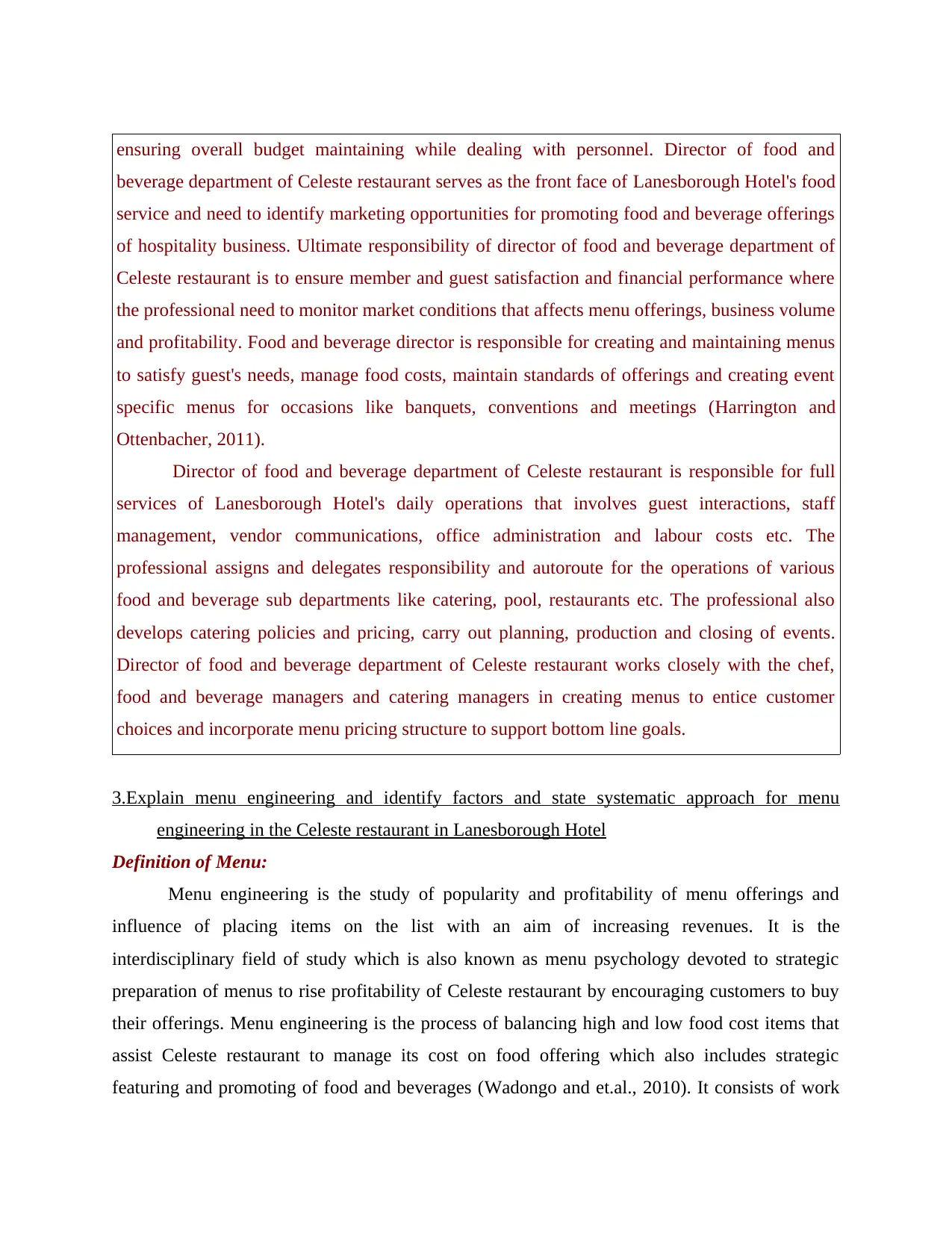
ensuring overall budget maintaining while dealing with personnel. Director of food and
beverage department of Celeste restaurant serves as the front face of Lanesborough Hotel's food
service and need to identify marketing opportunities for promoting food and beverage offerings
of hospitality business. Ultimate responsibility of director of food and beverage department of
Celeste restaurant is to ensure member and guest satisfaction and financial performance where
the professional need to monitor market conditions that affects menu offerings, business volume
and profitability. Food and beverage director is responsible for creating and maintaining menus
to satisfy guest's needs, manage food costs, maintain standards of offerings and creating event
specific menus for occasions like banquets, conventions and meetings (Harrington and
Ottenbacher, 2011).
Director of food and beverage department of Celeste restaurant is responsible for full
services of Lanesborough Hotel's daily operations that involves guest interactions, staff
management, vendor communications, office administration and labour costs etc. The
professional assigns and delegates responsibility and autoroute for the operations of various
food and beverage sub departments like catering, pool, restaurants etc. The professional also
develops catering policies and pricing, carry out planning, production and closing of events.
Director of food and beverage department of Celeste restaurant works closely with the chef,
food and beverage managers and catering managers in creating menus to entice customer
choices and incorporate menu pricing structure to support bottom line goals.
3.Explain menu engineering and identify factors and state systematic approach for menu
engineering in the Celeste restaurant in Lanesborough Hotel
Definition of Menu:
Menu engineering is the study of popularity and profitability of menu offerings and
influence of placing items on the list with an aim of increasing revenues. It is the
interdisciplinary field of study which is also known as menu psychology devoted to strategic
preparation of menus to rise profitability of Celeste restaurant by encouraging customers to buy
their offerings. Menu engineering is the process of balancing high and low food cost items that
assist Celeste restaurant to manage its cost on food offering which also includes strategic
featuring and promoting of food and beverages (Wadongo and et.al., 2010). It consists of work
beverage department of Celeste restaurant serves as the front face of Lanesborough Hotel's food
service and need to identify marketing opportunities for promoting food and beverage offerings
of hospitality business. Ultimate responsibility of director of food and beverage department of
Celeste restaurant is to ensure member and guest satisfaction and financial performance where
the professional need to monitor market conditions that affects menu offerings, business volume
and profitability. Food and beverage director is responsible for creating and maintaining menus
to satisfy guest's needs, manage food costs, maintain standards of offerings and creating event
specific menus for occasions like banquets, conventions and meetings (Harrington and
Ottenbacher, 2011).
Director of food and beverage department of Celeste restaurant is responsible for full
services of Lanesborough Hotel's daily operations that involves guest interactions, staff
management, vendor communications, office administration and labour costs etc. The
professional assigns and delegates responsibility and autoroute for the operations of various
food and beverage sub departments like catering, pool, restaurants etc. The professional also
develops catering policies and pricing, carry out planning, production and closing of events.
Director of food and beverage department of Celeste restaurant works closely with the chef,
food and beverage managers and catering managers in creating menus to entice customer
choices and incorporate menu pricing structure to support bottom line goals.
3.Explain menu engineering and identify factors and state systematic approach for menu
engineering in the Celeste restaurant in Lanesborough Hotel
Definition of Menu:
Menu engineering is the study of popularity and profitability of menu offerings and
influence of placing items on the list with an aim of increasing revenues. It is the
interdisciplinary field of study which is also known as menu psychology devoted to strategic
preparation of menus to rise profitability of Celeste restaurant by encouraging customers to buy
their offerings. Menu engineering is the process of balancing high and low food cost items that
assist Celeste restaurant to manage its cost on food offering which also includes strategic
featuring and promoting of food and beverages (Wadongo and et.al., 2010). It consists of work
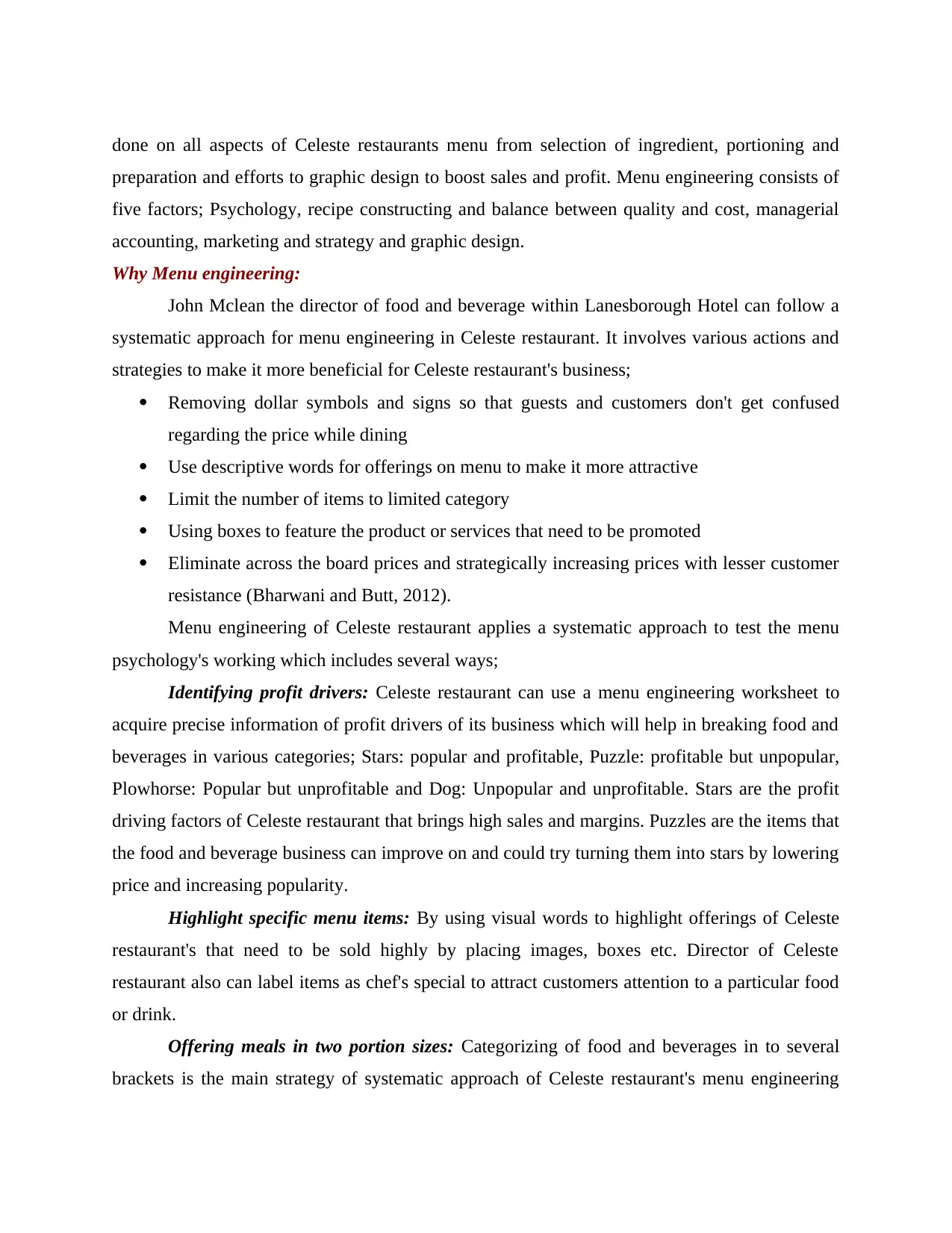
done on all aspects of Celeste restaurants menu from selection of ingredient, portioning and
preparation and efforts to graphic design to boost sales and profit. Menu engineering consists of
five factors; Psychology, recipe constructing and balance between quality and cost, managerial
accounting, marketing and strategy and graphic design.
Why Menu engineering:
John Mclean the director of food and beverage within Lanesborough Hotel can follow a
systematic approach for menu engineering in Celeste restaurant. It involves various actions and
strategies to make it more beneficial for Celeste restaurant's business;
Removing dollar symbols and signs so that guests and customers don't get confused
regarding the price while dining
Use descriptive words for offerings on menu to make it more attractive
Limit the number of items to limited category
Using boxes to feature the product or services that need to be promoted
Eliminate across the board prices and strategically increasing prices with lesser customer
resistance (Bharwani and Butt, 2012).
Menu engineering of Celeste restaurant applies a systematic approach to test the menu
psychology's working which includes several ways;
Identifying profit drivers: Celeste restaurant can use a menu engineering worksheet to
acquire precise information of profit drivers of its business which will help in breaking food and
beverages in various categories; Stars: popular and profitable, Puzzle: profitable but unpopular,
Plowhorse: Popular but unprofitable and Dog: Unpopular and unprofitable. Stars are the profit
driving factors of Celeste restaurant that brings high sales and margins. Puzzles are the items that
the food and beverage business can improve on and could try turning them into stars by lowering
price and increasing popularity.
Highlight specific menu items: By using visual words to highlight offerings of Celeste
restaurant's that need to be sold highly by placing images, boxes etc. Director of Celeste
restaurant also can label items as chef's special to attract customers attention to a particular food
or drink.
Offering meals in two portion sizes: Categorizing of food and beverages in to several
brackets is the main strategy of systematic approach of Celeste restaurant's menu engineering
preparation and efforts to graphic design to boost sales and profit. Menu engineering consists of
five factors; Psychology, recipe constructing and balance between quality and cost, managerial
accounting, marketing and strategy and graphic design.
Why Menu engineering:
John Mclean the director of food and beverage within Lanesborough Hotel can follow a
systematic approach for menu engineering in Celeste restaurant. It involves various actions and
strategies to make it more beneficial for Celeste restaurant's business;
Removing dollar symbols and signs so that guests and customers don't get confused
regarding the price while dining
Use descriptive words for offerings on menu to make it more attractive
Limit the number of items to limited category
Using boxes to feature the product or services that need to be promoted
Eliminate across the board prices and strategically increasing prices with lesser customer
resistance (Bharwani and Butt, 2012).
Menu engineering of Celeste restaurant applies a systematic approach to test the menu
psychology's working which includes several ways;
Identifying profit drivers: Celeste restaurant can use a menu engineering worksheet to
acquire precise information of profit drivers of its business which will help in breaking food and
beverages in various categories; Stars: popular and profitable, Puzzle: profitable but unpopular,
Plowhorse: Popular but unprofitable and Dog: Unpopular and unprofitable. Stars are the profit
driving factors of Celeste restaurant that brings high sales and margins. Puzzles are the items that
the food and beverage business can improve on and could try turning them into stars by lowering
price and increasing popularity.
Highlight specific menu items: By using visual words to highlight offerings of Celeste
restaurant's that need to be sold highly by placing images, boxes etc. Director of Celeste
restaurant also can label items as chef's special to attract customers attention to a particular food
or drink.
Offering meals in two portion sizes: Categorizing of food and beverages in to several
brackets is the main strategy of systematic approach of Celeste restaurant's menu engineering
Secure Best Marks with AI Grader
Need help grading? Try our AI Grader for instant feedback on your assignments.
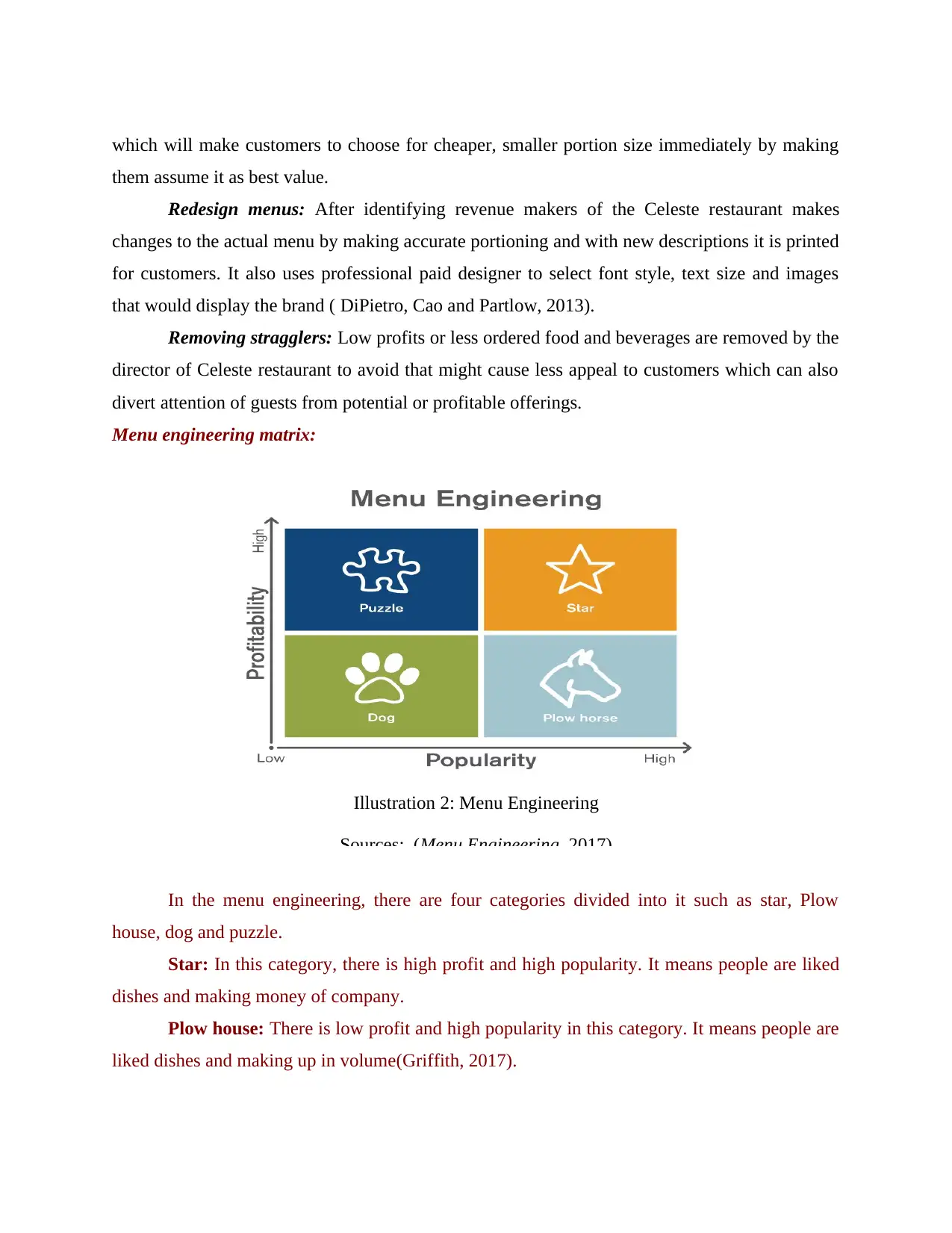
which will make customers to choose for cheaper, smaller portion size immediately by making
them assume it as best value.
Redesign menus: After identifying revenue makers of the Celeste restaurant makes
changes to the actual menu by making accurate portioning and with new descriptions it is printed
for customers. It also uses professional paid designer to select font style, text size and images
that would display the brand ( DiPietro, Cao and Partlow, 2013).
Removing stragglers: Low profits or less ordered food and beverages are removed by the
director of Celeste restaurant to avoid that might cause less appeal to customers which can also
divert attention of guests from potential or profitable offerings.
Menu engineering matrix:
In the menu engineering, there are four categories divided into it such as star, Plow
house, dog and puzzle.
Star: In this category, there is high profit and high popularity. It means people are liked
dishes and making money of company.
Plow house: There is low profit and high popularity in this category. It means people are
liked dishes and making up in volume(Griffith, 2017).
Illustration 2: Menu Engineering
Sources: (Menu Engineering, 2017)
them assume it as best value.
Redesign menus: After identifying revenue makers of the Celeste restaurant makes
changes to the actual menu by making accurate portioning and with new descriptions it is printed
for customers. It also uses professional paid designer to select font style, text size and images
that would display the brand ( DiPietro, Cao and Partlow, 2013).
Removing stragglers: Low profits or less ordered food and beverages are removed by the
director of Celeste restaurant to avoid that might cause less appeal to customers which can also
divert attention of guests from potential or profitable offerings.
Menu engineering matrix:
In the menu engineering, there are four categories divided into it such as star, Plow
house, dog and puzzle.
Star: In this category, there is high profit and high popularity. It means people are liked
dishes and making money of company.
Plow house: There is low profit and high popularity in this category. It means people are
liked dishes and making up in volume(Griffith, 2017).
Illustration 2: Menu Engineering
Sources: (Menu Engineering, 2017)
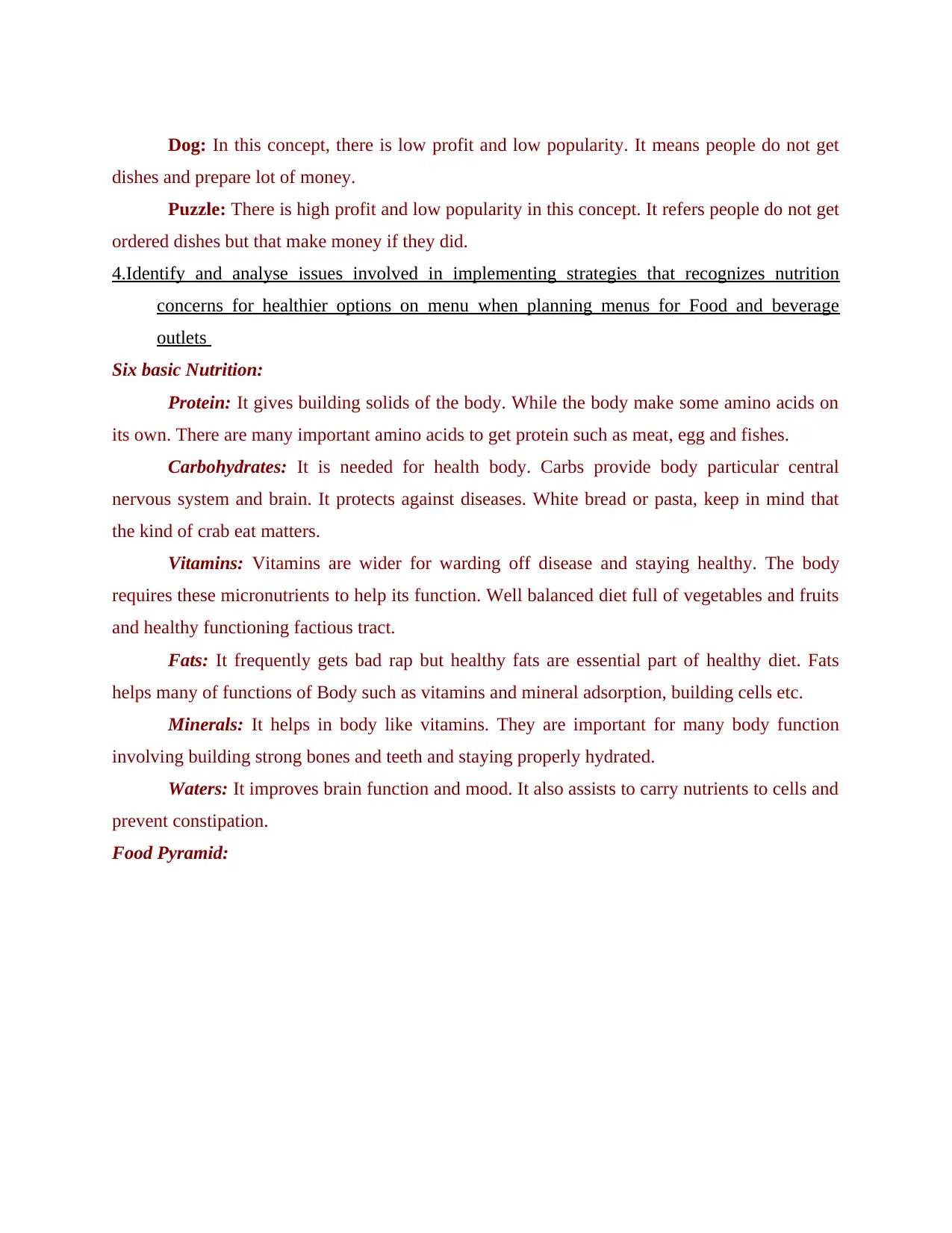
Dog: In this concept, there is low profit and low popularity. It means people do not get
dishes and prepare lot of money.
Puzzle: There is high profit and low popularity in this concept. It refers people do not get
ordered dishes but that make money if they did.
4.Identify and analyse issues involved in implementing strategies that recognizes nutrition
concerns for healthier options on menu when planning menus for Food and beverage
outlets
Six basic Nutrition:
Protein: It gives building solids of the body. While the body make some amino acids on
its own. There are many important amino acids to get protein such as meat, egg and fishes.
Carbohydrates: It is needed for health body. Carbs provide body particular central
nervous system and brain. It protects against diseases. White bread or pasta, keep in mind that
the kind of crab eat matters.
Vitamins: Vitamins are wider for warding off disease and staying healthy. The body
requires these micronutrients to help its function. Well balanced diet full of vegetables and fruits
and healthy functioning factious tract.
Fats: It frequently gets bad rap but healthy fats are essential part of healthy diet. Fats
helps many of functions of Body such as vitamins and mineral adsorption, building cells etc.
Minerals: It helps in body like vitamins. They are important for many body function
involving building strong bones and teeth and staying properly hydrated.
Waters: It improves brain function and mood. It also assists to carry nutrients to cells and
prevent constipation.
Food Pyramid:
dishes and prepare lot of money.
Puzzle: There is high profit and low popularity in this concept. It refers people do not get
ordered dishes but that make money if they did.
4.Identify and analyse issues involved in implementing strategies that recognizes nutrition
concerns for healthier options on menu when planning menus for Food and beverage
outlets
Six basic Nutrition:
Protein: It gives building solids of the body. While the body make some amino acids on
its own. There are many important amino acids to get protein such as meat, egg and fishes.
Carbohydrates: It is needed for health body. Carbs provide body particular central
nervous system and brain. It protects against diseases. White bread or pasta, keep in mind that
the kind of crab eat matters.
Vitamins: Vitamins are wider for warding off disease and staying healthy. The body
requires these micronutrients to help its function. Well balanced diet full of vegetables and fruits
and healthy functioning factious tract.
Fats: It frequently gets bad rap but healthy fats are essential part of healthy diet. Fats
helps many of functions of Body such as vitamins and mineral adsorption, building cells etc.
Minerals: It helps in body like vitamins. They are important for many body function
involving building strong bones and teeth and staying properly hydrated.
Waters: It improves brain function and mood. It also assists to carry nutrients to cells and
prevent constipation.
Food Pyramid:
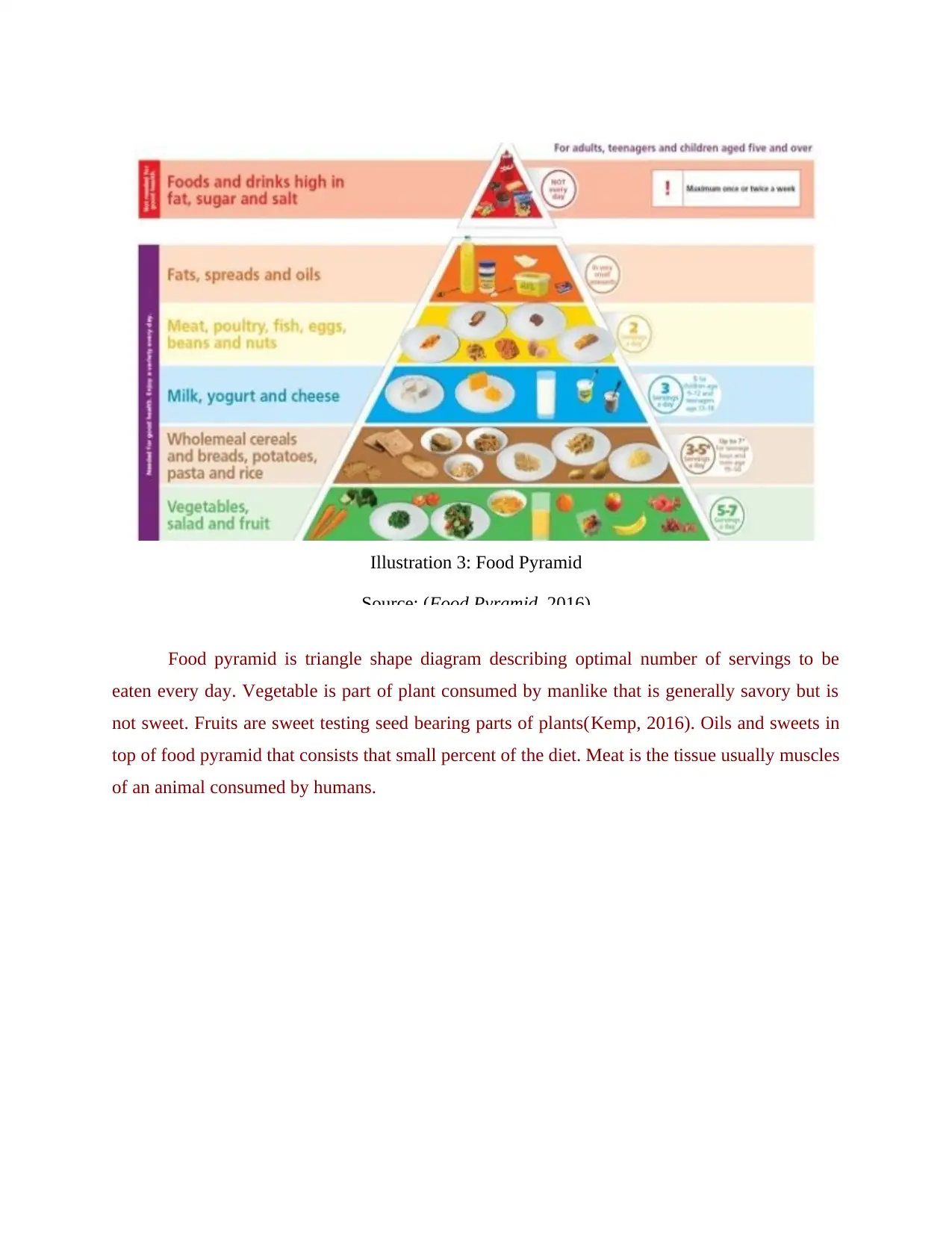
Food pyramid is triangle shape diagram describing optimal number of servings to be
eaten every day. Vegetable is part of plant consumed by manlike that is generally savory but is
not sweet. Fruits are sweet testing seed bearing parts of plants(Kemp, 2016). Oils and sweets in
top of food pyramid that consists that small percent of the diet. Meat is the tissue usually muscles
of an animal consumed by humans.
Illustration 3: Food Pyramid
Source: (Food Pyramid, 2016)
eaten every day. Vegetable is part of plant consumed by manlike that is generally savory but is
not sweet. Fruits are sweet testing seed bearing parts of plants(Kemp, 2016). Oils and sweets in
top of food pyramid that consists that small percent of the diet. Meat is the tissue usually muscles
of an animal consumed by humans.
Illustration 3: Food Pyramid
Source: (Food Pyramid, 2016)
Paraphrase This Document
Need a fresh take? Get an instant paraphrase of this document with our AI Paraphraser
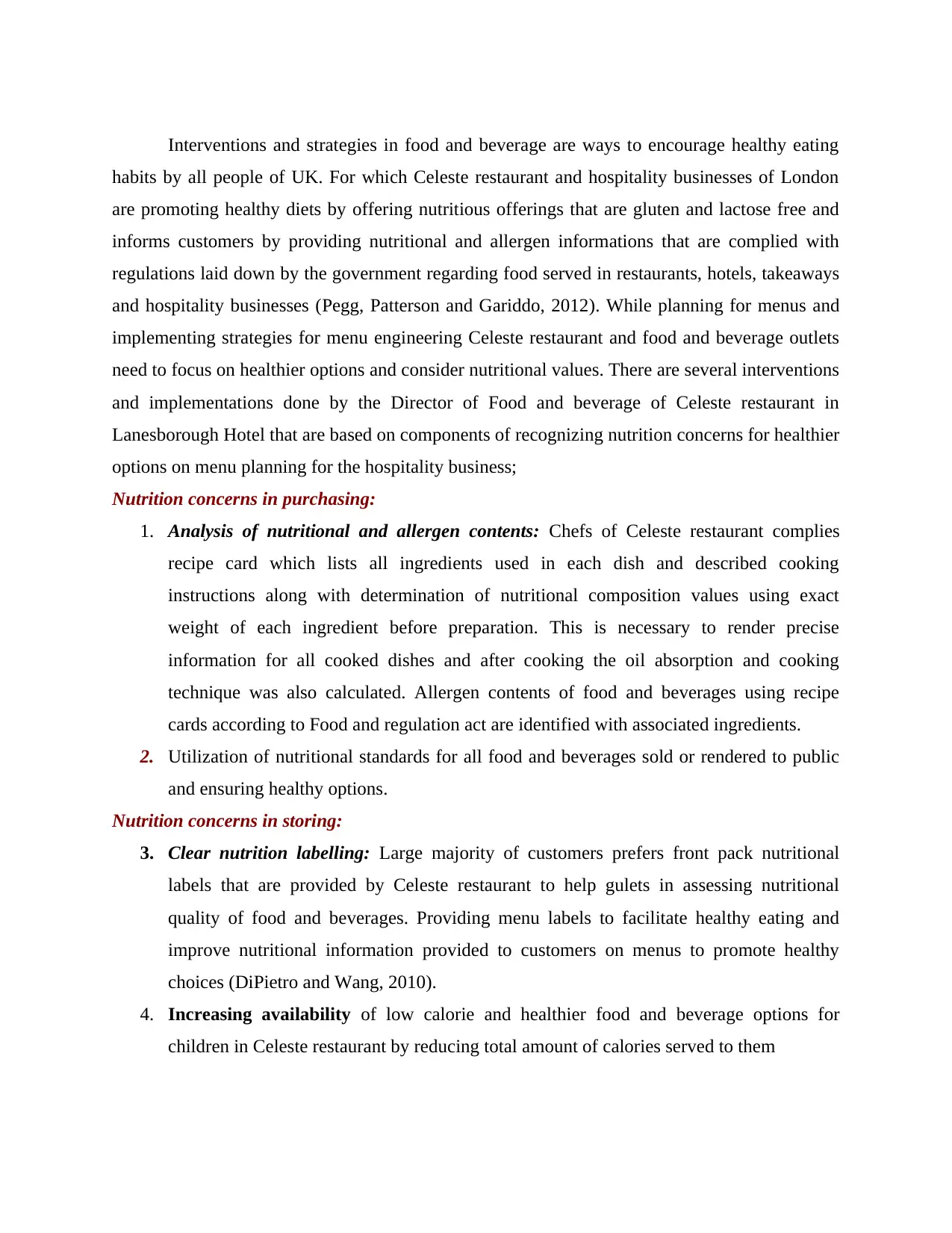
Interventions and strategies in food and beverage are ways to encourage healthy eating
habits by all people of UK. For which Celeste restaurant and hospitality businesses of London
are promoting healthy diets by offering nutritious offerings that are gluten and lactose free and
informs customers by providing nutritional and allergen informations that are complied with
regulations laid down by the government regarding food served in restaurants, hotels, takeaways
and hospitality businesses (Pegg, Patterson and Gariddo, 2012). While planning for menus and
implementing strategies for menu engineering Celeste restaurant and food and beverage outlets
need to focus on healthier options and consider nutritional values. There are several interventions
and implementations done by the Director of Food and beverage of Celeste restaurant in
Lanesborough Hotel that are based on components of recognizing nutrition concerns for healthier
options on menu planning for the hospitality business;
Nutrition concerns in purchasing:
1. Analysis of nutritional and allergen contents: Chefs of Celeste restaurant complies
recipe card which lists all ingredients used in each dish and described cooking
instructions along with determination of nutritional composition values using exact
weight of each ingredient before preparation. This is necessary to render precise
information for all cooked dishes and after cooking the oil absorption and cooking
technique was also calculated. Allergen contents of food and beverages using recipe
cards according to Food and regulation act are identified with associated ingredients.
2. Utilization of nutritional standards for all food and beverages sold or rendered to public
and ensuring healthy options.
Nutrition concerns in storing:
3. Clear nutrition labelling: Large majority of customers prefers front pack nutritional
labels that are provided by Celeste restaurant to help gulets in assessing nutritional
quality of food and beverages. Providing menu labels to facilitate healthy eating and
improve nutritional information provided to customers on menus to promote healthy
choices (DiPietro and Wang, 2010).
4. Increasing availability of low calorie and healthier food and beverage options for
children in Celeste restaurant by reducing total amount of calories served to them
habits by all people of UK. For which Celeste restaurant and hospitality businesses of London
are promoting healthy diets by offering nutritious offerings that are gluten and lactose free and
informs customers by providing nutritional and allergen informations that are complied with
regulations laid down by the government regarding food served in restaurants, hotels, takeaways
and hospitality businesses (Pegg, Patterson and Gariddo, 2012). While planning for menus and
implementing strategies for menu engineering Celeste restaurant and food and beverage outlets
need to focus on healthier options and consider nutritional values. There are several interventions
and implementations done by the Director of Food and beverage of Celeste restaurant in
Lanesborough Hotel that are based on components of recognizing nutrition concerns for healthier
options on menu planning for the hospitality business;
Nutrition concerns in purchasing:
1. Analysis of nutritional and allergen contents: Chefs of Celeste restaurant complies
recipe card which lists all ingredients used in each dish and described cooking
instructions along with determination of nutritional composition values using exact
weight of each ingredient before preparation. This is necessary to render precise
information for all cooked dishes and after cooking the oil absorption and cooking
technique was also calculated. Allergen contents of food and beverages using recipe
cards according to Food and regulation act are identified with associated ingredients.
2. Utilization of nutritional standards for all food and beverages sold or rendered to public
and ensuring healthy options.
Nutrition concerns in storing:
3. Clear nutrition labelling: Large majority of customers prefers front pack nutritional
labels that are provided by Celeste restaurant to help gulets in assessing nutritional
quality of food and beverages. Providing menu labels to facilitate healthy eating and
improve nutritional information provided to customers on menus to promote healthy
choices (DiPietro and Wang, 2010).
4. Increasing availability of low calorie and healthier food and beverage options for
children in Celeste restaurant by reducing total amount of calories served to them
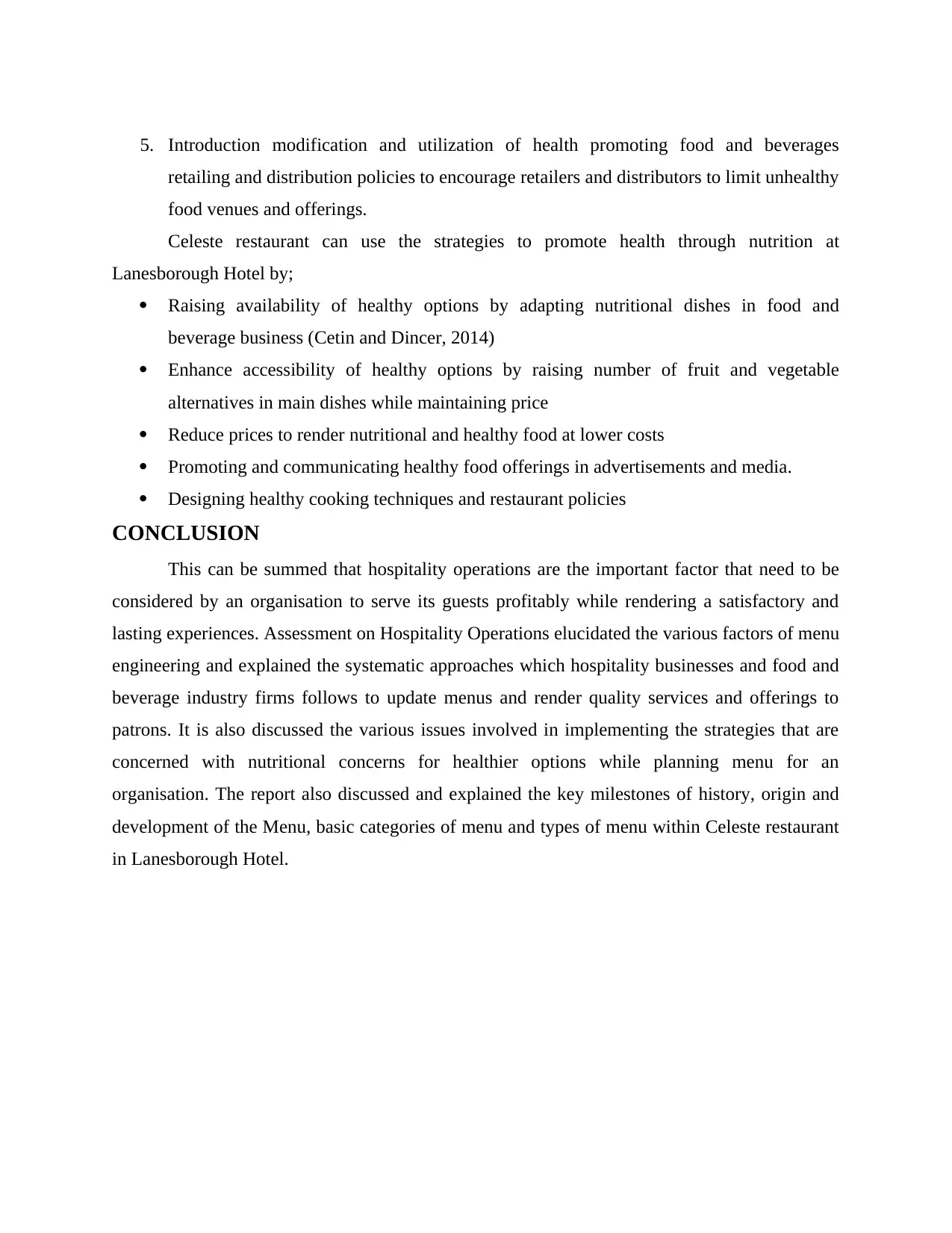
5. Introduction modification and utilization of health promoting food and beverages
retailing and distribution policies to encourage retailers and distributors to limit unhealthy
food venues and offerings.
Celeste restaurant can use the strategies to promote health through nutrition at
Lanesborough Hotel by;
Raising availability of healthy options by adapting nutritional dishes in food and
beverage business (Cetin and Dincer, 2014)
Enhance accessibility of healthy options by raising number of fruit and vegetable
alternatives in main dishes while maintaining price
Reduce prices to render nutritional and healthy food at lower costs
Promoting and communicating healthy food offerings in advertisements and media.
Designing healthy cooking techniques and restaurant policies
CONCLUSION
This can be summed that hospitality operations are the important factor that need to be
considered by an organisation to serve its guests profitably while rendering a satisfactory and
lasting experiences. Assessment on Hospitality Operations elucidated the various factors of menu
engineering and explained the systematic approaches which hospitality businesses and food and
beverage industry firms follows to update menus and render quality services and offerings to
patrons. It is also discussed the various issues involved in implementing the strategies that are
concerned with nutritional concerns for healthier options while planning menu for an
organisation. The report also discussed and explained the key milestones of history, origin and
development of the Menu, basic categories of menu and types of menu within Celeste restaurant
in Lanesborough Hotel.
retailing and distribution policies to encourage retailers and distributors to limit unhealthy
food venues and offerings.
Celeste restaurant can use the strategies to promote health through nutrition at
Lanesborough Hotel by;
Raising availability of healthy options by adapting nutritional dishes in food and
beverage business (Cetin and Dincer, 2014)
Enhance accessibility of healthy options by raising number of fruit and vegetable
alternatives in main dishes while maintaining price
Reduce prices to render nutritional and healthy food at lower costs
Promoting and communicating healthy food offerings in advertisements and media.
Designing healthy cooking techniques and restaurant policies
CONCLUSION
This can be summed that hospitality operations are the important factor that need to be
considered by an organisation to serve its guests profitably while rendering a satisfactory and
lasting experiences. Assessment on Hospitality Operations elucidated the various factors of menu
engineering and explained the systematic approaches which hospitality businesses and food and
beverage industry firms follows to update menus and render quality services and offerings to
patrons. It is also discussed the various issues involved in implementing the strategies that are
concerned with nutritional concerns for healthier options while planning menu for an
organisation. The report also discussed and explained the key milestones of history, origin and
development of the Menu, basic categories of menu and types of menu within Celeste restaurant
in Lanesborough Hotel.
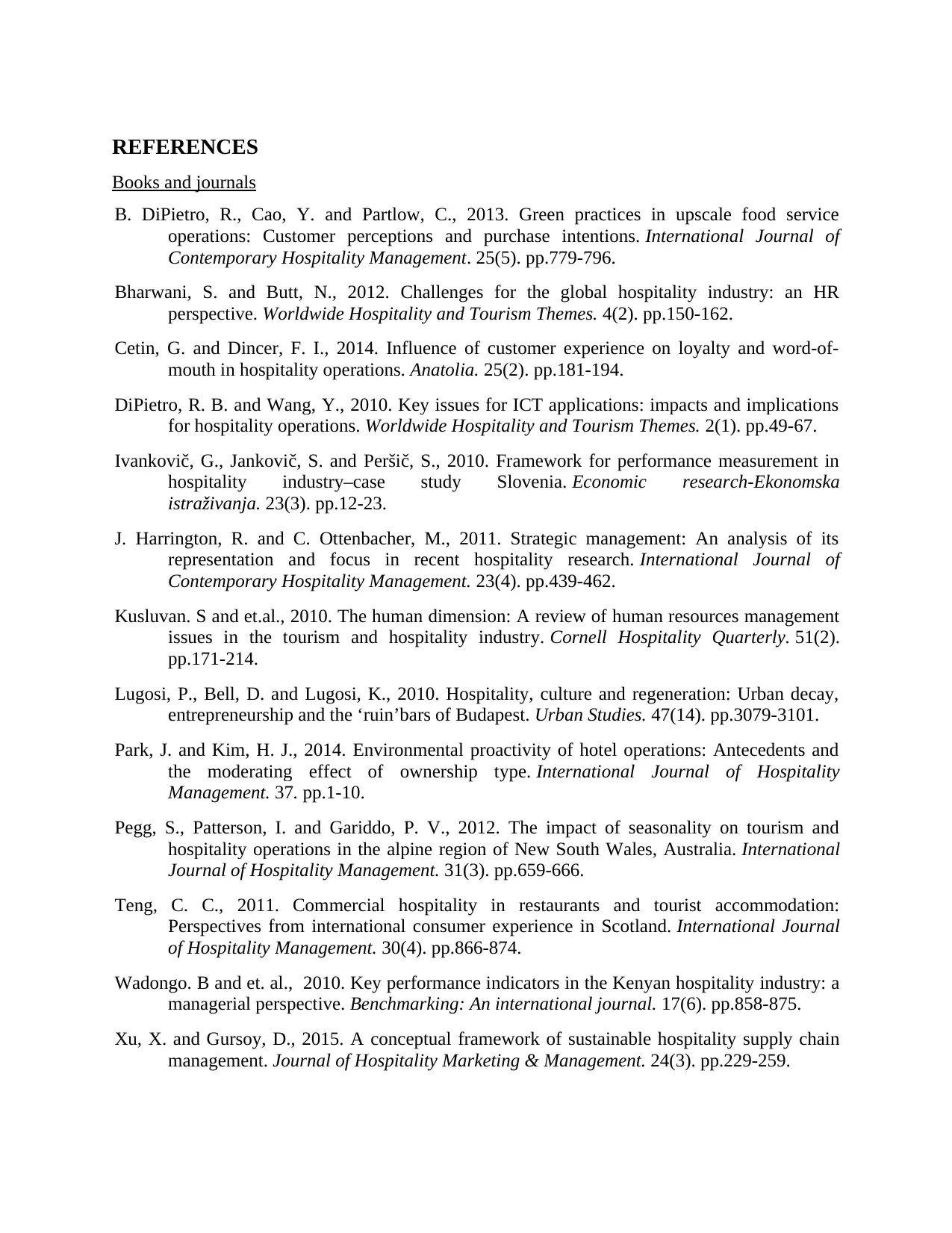
REFERENCES
Books and journals
B. DiPietro, R., Cao, Y. and Partlow, C., 2013. Green practices in upscale food service
operations: Customer perceptions and purchase intentions. International Journal of
Contemporary Hospitality Management. 25(5). pp.779-796.
Bharwani, S. and Butt, N., 2012. Challenges for the global hospitality industry: an HR
perspective. Worldwide Hospitality and Tourism Themes. 4(2). pp.150-162.
Cetin, G. and Dincer, F. I., 2014. Influence of customer experience on loyalty and word-of-
mouth in hospitality operations. Anatolia. 25(2). pp.181-194.
DiPietro, R. B. and Wang, Y., 2010. Key issues for ICT applications: impacts and implications
for hospitality operations. Worldwide Hospitality and Tourism Themes. 2(1). pp.49-67.
Ivankovič, G., Jankovič, S. and Peršič, S., 2010. Framework for performance measurement in
hospitality industry–case study Slovenia. Economic research-Ekonomska
istraživanja. 23(3). pp.12-23.
J. Harrington, R. and C. Ottenbacher, M., 2011. Strategic management: An analysis of its
representation and focus in recent hospitality research. International Journal of
Contemporary Hospitality Management. 23(4). pp.439-462.
Kusluvan. S and et.al., 2010. The human dimension: A review of human resources management
issues in the tourism and hospitality industry. Cornell Hospitality Quarterly. 51(2).
pp.171-214.
Lugosi, P., Bell, D. and Lugosi, K., 2010. Hospitality, culture and regeneration: Urban decay,
entrepreneurship and the ‘ruin’bars of Budapest. Urban Studies. 47(14). pp.3079-3101.
Park, J. and Kim, H. J., 2014. Environmental proactivity of hotel operations: Antecedents and
the moderating effect of ownership type. International Journal of Hospitality
Management. 37. pp.1-10.
Pegg, S., Patterson, I. and Gariddo, P. V., 2012. The impact of seasonality on tourism and
hospitality operations in the alpine region of New South Wales, Australia. International
Journal of Hospitality Management. 31(3). pp.659-666.
Teng, C. C., 2011. Commercial hospitality in restaurants and tourist accommodation:
Perspectives from international consumer experience in Scotland. International Journal
of Hospitality Management. 30(4). pp.866-874.
Wadongo. B and et. al., 2010. Key performance indicators in the Kenyan hospitality industry: a
managerial perspective. Benchmarking: An international journal. 17(6). pp.858-875.
Xu, X. and Gursoy, D., 2015. A conceptual framework of sustainable hospitality supply chain
management. Journal of Hospitality Marketing & Management. 24(3). pp.229-259.
Books and journals
B. DiPietro, R., Cao, Y. and Partlow, C., 2013. Green practices in upscale food service
operations: Customer perceptions and purchase intentions. International Journal of
Contemporary Hospitality Management. 25(5). pp.779-796.
Bharwani, S. and Butt, N., 2012. Challenges for the global hospitality industry: an HR
perspective. Worldwide Hospitality and Tourism Themes. 4(2). pp.150-162.
Cetin, G. and Dincer, F. I., 2014. Influence of customer experience on loyalty and word-of-
mouth in hospitality operations. Anatolia. 25(2). pp.181-194.
DiPietro, R. B. and Wang, Y., 2010. Key issues for ICT applications: impacts and implications
for hospitality operations. Worldwide Hospitality and Tourism Themes. 2(1). pp.49-67.
Ivankovič, G., Jankovič, S. and Peršič, S., 2010. Framework for performance measurement in
hospitality industry–case study Slovenia. Economic research-Ekonomska
istraživanja. 23(3). pp.12-23.
J. Harrington, R. and C. Ottenbacher, M., 2011. Strategic management: An analysis of its
representation and focus in recent hospitality research. International Journal of
Contemporary Hospitality Management. 23(4). pp.439-462.
Kusluvan. S and et.al., 2010. The human dimension: A review of human resources management
issues in the tourism and hospitality industry. Cornell Hospitality Quarterly. 51(2).
pp.171-214.
Lugosi, P., Bell, D. and Lugosi, K., 2010. Hospitality, culture and regeneration: Urban decay,
entrepreneurship and the ‘ruin’bars of Budapest. Urban Studies. 47(14). pp.3079-3101.
Park, J. and Kim, H. J., 2014. Environmental proactivity of hotel operations: Antecedents and
the moderating effect of ownership type. International Journal of Hospitality
Management. 37. pp.1-10.
Pegg, S., Patterson, I. and Gariddo, P. V., 2012. The impact of seasonality on tourism and
hospitality operations in the alpine region of New South Wales, Australia. International
Journal of Hospitality Management. 31(3). pp.659-666.
Teng, C. C., 2011. Commercial hospitality in restaurants and tourist accommodation:
Perspectives from international consumer experience in Scotland. International Journal
of Hospitality Management. 30(4). pp.866-874.
Wadongo. B and et. al., 2010. Key performance indicators in the Kenyan hospitality industry: a
managerial perspective. Benchmarking: An international journal. 17(6). pp.858-875.
Xu, X. and Gursoy, D., 2015. A conceptual framework of sustainable hospitality supply chain
management. Journal of Hospitality Marketing & Management. 24(3). pp.229-259.
Secure Best Marks with AI Grader
Need help grading? Try our AI Grader for instant feedback on your assignments.
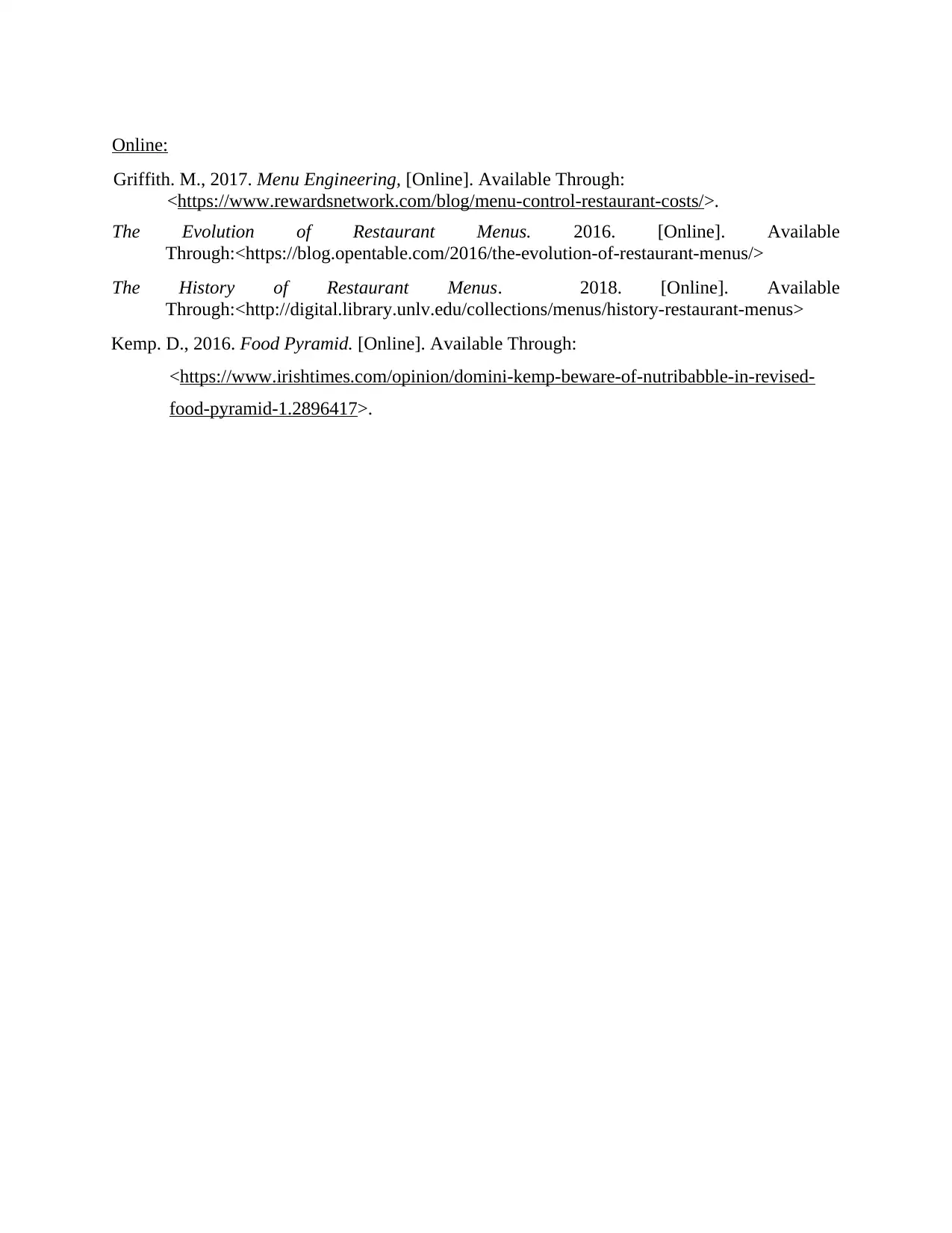
Online:
Griffith. M., 2017. Menu Engineering, [Online]. Available Through:
<https://www.rewardsnetwork.com/blog/menu-control-restaurant-costs/>.
The Evolution of Restaurant Menus. 2016. [Online]. Available
Through:<https://blog.opentable.com/2016/the-evolution-of-restaurant-menus/>
The History of Restaurant Menus. 2018. [Online]. Available
Through:<http://digital.library.unlv.edu/collections/menus/history-restaurant-menus>
Kemp. D., 2016. Food Pyramid. [Online]. Available Through:
<https://www.irishtimes.com/opinion/domini-kemp-beware-of-nutribabble-in-revised-
food-pyramid-1.2896417>.
Griffith. M., 2017. Menu Engineering, [Online]. Available Through:
<https://www.rewardsnetwork.com/blog/menu-control-restaurant-costs/>.
The Evolution of Restaurant Menus. 2016. [Online]. Available
Through:<https://blog.opentable.com/2016/the-evolution-of-restaurant-menus/>
The History of Restaurant Menus. 2018. [Online]. Available
Through:<http://digital.library.unlv.edu/collections/menus/history-restaurant-menus>
Kemp. D., 2016. Food Pyramid. [Online]. Available Through:
<https://www.irishtimes.com/opinion/domini-kemp-beware-of-nutribabble-in-revised-
food-pyramid-1.2896417>.
1 out of 17
Related Documents
Your All-in-One AI-Powered Toolkit for Academic Success.
+13062052269
info@desklib.com
Available 24*7 on WhatsApp / Email
![[object Object]](/_next/static/media/star-bottom.7253800d.svg)
Unlock your academic potential
© 2024 | Zucol Services PVT LTD | All rights reserved.





